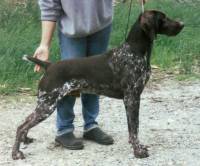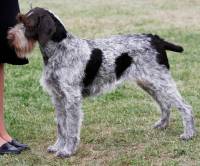German Shorthaired Pointers
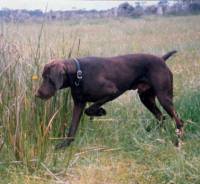 German Shorthaired Pointer
German Shorthaired Pointer
The German Shorthaired and Wirehaired Pointers are popular in Australia as the Rough Shooters' dog that can hunt, point and retrieve. Additionally they are able to track and mark wounded game both by foot-scent and air-scent. But not only are they staunch and steady in the field, they make obedient and lovable companions at home.
History of the German Shorthaired Pointer
 Spanish Pointer c 1775
Spanish Pointer c 1775
Ancient German Sporting Dogs had long, rounded ears and profiles without a definite stop. They were probably descended from the Spanish Pointer (now extinct) which was introduced into Germany by Flemish hunters in the 1600's. Usually liver and white, this dog had a heavy head and jowl, deep flews, a definite stop, upturned large nostrils, a heavy body, huge bone and docked tail. It was an excellent Pointer who found game by air borne scent and hesitated before springing. This was useful when used for falconry. But his cumbersome build proved too slow for safe use with muzzle loading guns, the old type of firearms.
By the early 1800's, the Germans had combined the Old Spanish Pointer with an ancient dog developed from the St Hubert Hound or Bloodhound which had cold-trailing abilities of following scent on the ground. This original type of Scent Hound originated in the East and was brought to Europe by the Crusaders along with new kinds of other things like beautiful horses and stunning architecture. By combining the Old Spanish Pointer with this hound, the Germans were better able to fulfil their humane 'Hunting Code Obligation' in which the hunter would find and put out of misery any creature they had wounded. Additionally
'The use of firearms in hunting and the break-up of many of the large middle-European estates after the French Revolution and Napoleonic wars influenced the selection of dogs suitable for contemporary hunting. The British, with intact aristocracy retaining large landholdings, maintained specialist breeds: the Pointer (English), the Setters, the Retrievers, and several varieties of Spaniels for work in heavy cover. The middle Europeans found their requirements best served by a dog which would hunt, point, retrieve and follow blood scent: an all-purpose gundog'[8].
 Hannover Schweisshund
Hannover Schweisshund
To this end, the German Schweisshund, a breed similar to the Hannover Schweisshund (pictured) was used[1]. Enthusiasts such as Dr Paul Kleeman, President of the Berlin Club, H F Seiger, E V Otto and Dr Von Dewitz were just a few who ruthlessly culled the slightest fault which could possibly hamper their requirements of the development of a breed with beauty, versatility and an enthusiastic hunting ability[9].
The German Shorthaired Pointer become a Pure Breed
 German Pointer 1890
German Pointer 1890
As guns became more modernised, the independent-minded shooter even in England required just one dog, which became known as the 'German Pointer'. An early example of this dog was Hector Fodersdorf (pictured), called a 'German Pointer' when he was exhibited in England in in 1887. This particular dog who stood 55 cm at the shoulder is preserved, mounted and on display at the British Museum of Natural History at Tring, UK[2].
 German Shorthaired Pointer pup
German Shorthaired Pointer pup
So the GSP we know today is the product of the careful blending of the Old Spanish Pointer with the German Schweisshund, selected on the basis of 'Through Performance to Type[6]'. This useful handy sized dog can hunt by foot and air as well as point and retrieve. Hence one multi-tasked dog can do more than fill the role of specialised Setters, Pointers and Retrievers, their instinct becoming evident from a very young age as demonstrated by the pup pictured.
History of German Shorthaired Pointers in Australia
 Jack Thompson, Ship's Official and GSP's (1962)
Jack Thompson, Ship's Official and GSP's (1962)
Australia's first two German Shorthaired Pointers (GSP) arrived Port Melbourne in November 1962 having sailed from UK. They were imported by Jack Thompson, who was later to become known as 'the Father of the GSP in Australia'. Pictured here from left to right are Dunpender Eva (with Jack) and Heathman of Friuli their combined names making up Jack's prefix 'Dunfrui'. Selected by Scottish breeder Micheal Brander, these two founded what was to become one of the most famous working Gundog dynasties in Australia's history.
Jack was not only a clever breeder, he had the vision to establish this new breed, the GSP in Australia. An exceptionally successful Rough Shooters' dog, it proved to work extremely well in our conditions. The GSP out-performed our other Gundog breeds not only in Field Trials, but also Retrieving Trials in the days before Specialised Utility Gundog Trials were available. In 1970, just eight years after the first two imports arrived here, it was written:
 Field Trial Ch and Retrieving Trial Ch Irus V.D.Saarner Mark (Imp Germany) 1967
Field Trial Ch and Retrieving Trial Ch Irus V.D.Saarner Mark (Imp Germany) 1967
Spectacular performance on duck swamps, where shooting of wildfowl is carried out often in searing temperatures, was the first step. Onlookers saw the short-coated GSP outperforming the slower-moving, heavier built Labradors, Curly Coated Retrievers and suchlike because they were better equipped to withstand the above century conditions. Performances in the field, sometimes in even more stringent conditions, were also crowd pleasers, and the GSP began to come in ahead of the Pointers (English), Setters and the like in competitive Field Trials[4].
 Jack with another import
Jack with another import
After the initial success of the first pair, Jack brought out more carefully selected imports and founded the GSP right across Australia. Not only did these dogs do well in Field Trails, they also made their presence felt in the show ring. Within 10 years of the first pair stepping off that ship, an estimated 3,000 were owned in Australia, with 60 of them entered in the 1972 Royal Melbourne Show[7]. The accompanying photo is of a Field Trial also in 1972 with Jack Thompson and Jack Pontin. This illustrates that the GSP's prowess in Field Trials as well as their noble appearance and harmonious smooth outline, rightly earned them a place amongst Australia's most versatile Gundog breeds.
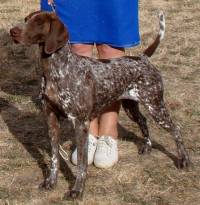 German Shorthaired Pointer
German Shorthaired Pointer
Although the first German Wirehaired Pointer arrived in Australia in 1976, it was not until the 1980's that this breed really became noticed[5]. Today they are kept alive by a small but dedicated band of enthusiasts.
Comparison between the German Shorthaired and Wirehaired Pointers
The obvious difference between these two breeds is their coat. However, at first glance in general balance German Shorthaired Pointers (GSP) may incorrectly be called square whereas the German Wirehaired Pointer allows up to 3 cms more length in the Breed Standard. Although the body of the GSP is proportionately shorter than some of the other Gundog breeds, his legs may appear just a little bit longer than his depth of body from withers to sternum as the accompanying photo demonstrates.
| German Shorthaired Pointer | German Wirehaired Pointer | |
|---|---|---|
| Coat |
The coat should be short and dense and although thinner and shorter on the head and ears, it should cover the whole body. The skin should be close and tight, without wrinkles. |
The double coat should have a dense, water resistant undercoat and a wire haired, harsh, flat, dense outer coat approximately 2 to 4 cm long especially on the eyebrows and beard. The coat length should not obscure the outline of the dog. |
| Colour |
|
Brown or black roan with or without white chest patches or light roan. No other colour permitted. |
|
|
|
|
| General Appearance |
|
The GWP has a noble appearance, his attentive expression indicating his energy. The length of his body should be as equal to his height at withers as possible, but not exceeding it by more than 3 cms. |
| Head | The head must be lean, but be in proportion with the the dog in length and strength, with the cheeks well muscled. | The head should be in proportion to the size and sex of the dog, and have slightly diverging head planes |
| Skull |
The skull should be moderately broad, rounded at the sides with the occipital bone just visible. However the brows should be moderately developed. |
The skull should be moderately broad and flat but rounded at the sides. However the brows should be well developed. |
| Stop | Moderately developed | Clearly and visibly pronounced. |
| Muzzle |
The muzzle should be strong, long and broad with the nasal bridge showing a slight rise above a straight line like a ram's nose, more prominent in males. The flews are not too pendulous with a broad somewhat protruding nose with mobile well pigmented nostrils coloured brown or black according to the colour of the dog. |
The muzzle should be strong, long and broad with the nasal bridge showing a slight rise above a straight line. The flews should be thick and close fitting. The lips and nose should be well pigmented, the colour corresponding with the coat. The nostrils should be well open. |
| Mouth | Teeth large, closing in a normal scissors bite preferably with full dentition | Teeth large, closing in a normal scissors bite preferably with full dentition |
|
|
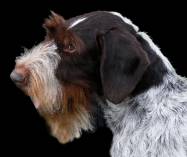 German Wirehaired Pointer German Wirehaired Pointer |
|
| Eyes |
The ideally dark brown, medium sized almond-shaped eyes should have tight fitting eyelids. |
The eyes should be as dark as possible, with well pigmented and close fitting eyelids. |
| Ears |
The ears should be moderately long and broad, set on high on and hanging straight and not twisted, close to the head level with the corner of the lips. |
The ears are of medium size but wide, set on high on the head and hang straight without twisting. |
| Neck |
Neck muscular and of sufficient length to balance the body with tight fitting skin at the throat, without dewlap. |
Neck strongly muscular and of medium length with a slight arch and a clean throat, without dewlap. |
| Forequarters |
The strongly muscled shoulders should be well muscled with the blades well laid back with a good open angle between the blade and the long upper arm. Viewed from the front, the strongly boned forelegs should be straight and parallel. When viewed from the side, the forelegs are placed well under the body with the elbows working close. The strong front pastern should have a minimal slope. |
The strongly muscled shoulders should have a good angle between the blade and the long upper arm. The distance from the elbows to the ground to be approximately equal to the distance from the elbows to the withers. Viewed from the front, the strongly boned lean forelegs should be straight and set well under the body with a definite slope in the front pastern. |
| Feet | Round to oval (spoon-shaped) with strong toenails and tough pads. | Round to oval with thick, tough, robust and well-pigmented pads. |
|
|
 German Wirehaired Pointer German Wirehaired Pointer |
|
| Body |
The withers are well defined, the back firm and muscular and the topline straight and slightly sloping towards the short loin with the croup sloping again to the tail set. The forechest is well defined with the sternum and elbow joint level. The chest is somewhat deeper than it is it broad but the ribs are well sprung without being flat or barrel shaped. The underline has an elegant arch, slightly tucked up towards the rear with no loose skin. |
The topline should be straight but slopes slightly towards the short muscular loin. The croup is long, broad and well-muscled and slants a little towards the broad pelvis. The forechest is broad, deep and well developed with the breastbone reaching as far back as possible. The ribs are well arched and the underline has an elegant curve towards the rear. |
| Hindquarters |
The long main bones of the hind legs form a good turn of stifle. The upper thighs are long, broad and muscular and the lower thighs also long and muscular but have clearly visible tendons forming a good angle with the vertical hocks. |
The hindquarters should be long, broad, muscular and well angulated at the stifles. The upper thighs are long, broad and muscular and the lower thighs long, broad and sinewy. When viewed from behind the hocks should be short, straight and perpendicular. |
| Gait |
The German Shorthaired Pointer should carry himself with a proud attitude, and move with far reaching, harmonious strides, with forceful propulsion from the hindquarters and adequate reach of the forelimbs. The front and hind legs should move straight and parallel. |
The German Wirehaired Pointer should have an upstanding posture and move covering lots of ground with good reach and drive, the front legs and hocks being parallel coming and going. His movement should be powerful, ground covering, flowing and harmonious. |
| Tail | The tail is set on as an extension of the topline, is strong at the root and then tapers. | The tail should follow the topline, carried as horizontally as possible or slightly raised. It should neither be too thick nor too thin. |
| Size |
Height at the withers |
Height at the withers |
References and Further Reading
Hot off the Press! Jane has just published a book 'Gundogs Unveiled'. Information on our sister website: www.Rangeairevision.com
Also published as "From Rough Shooting to Conservation" Published in Dog News Australia (Top Dog Media Pty Ltd Austral NSW) Issue 8, 2016 Page 10
[1] C Bede Maxwell - 'The New German Shorthaired Pointer' - Published by Howell Book House USA 1963. Library of Congress Catalogue Card Number 65-22999 Chapter 1 Origin and Early Development Pages 11 - 19
[2] Kim Dennis-Bryan and Juliet Clutton-Brock - 'Dogs of the Last Hundred Years at the British Museum' Published by British Museum (Natural History), London (1988) ISBN 0-565-01053-0 Page 44 German Pointer.
[3] Sharon Pinkerton - 'German Wirehaired Pointers Today' Published by Ringpress Books Pty Ltd, Letchworth, Hertz, UK 1994. ISBN 0-948955 49 X
[4] German Shorthaired Pointer Club of Victoria Inc. Extract from Newsletter April 1970 Page 20
[5] Ann Atkinson - 'The History of Purebred Dogs in Australia' published by OzDog Newspaper 1997 -the German Wirehaired Pointer Page 159
[6] C.Bede Maxwell, - 'The Truth about Sporting Dogs' Published 1972 by Howell Book House Inc 845 Third Avenue New York, NY 10022 The German Wirehaired Pointer Page 298
[7] Catalogue Royal Melbourne Show 1972, 21st - 30th September 1972 Published by the Royal Agricultural Society of Victoria
[8] Georgina Byrne - 'Der Deutsch-Kurahaar - the German Shothaired Pointer' - Published by Austed Publishing Company, Western Australia 1989, ISBN 1-86307-006-0 Chapter 1, Page 2
[9] Jack Thompson - 'The German Short-haired Pointer' Special Supplement. Published by National Dog Newspaper, Windsor NSW November 1977 Page 16
